Case No. Heisei 28 (gyo-ke) 10034
Decision date: September 21, 2016
Court: IP High Court
(https://www.courts.go.jp/assets/hanrei/hanrei-pdf-86156.pdf)
The plaintiff filed a design application with the drawings below representing the subject design as the article “Frozen Dessert”, but received a decision of rejection from the Examiner. The plaintiff filed an appeal against the Examiner’s decision of rejection with an amendment by which the article was amended to “Frozen Dessert with Container”, but the Japanese Patent Office (JPO) decided not to grant approval in the appeal. The plaintiff then filed an action for revocation of the JPO’s decision with the IP High Court.
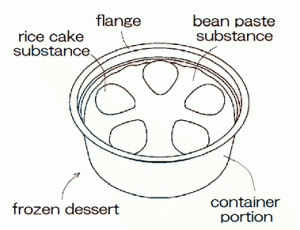
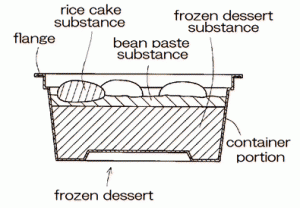
(Cited from the website of J-Plat Pat managed by National Center for
Industrial Property Information and Training)
Under Japanese Law, an application for design registration shall be filed for each design in accordance with a classification of articles as provided by the Ordinance of the Ministry of Economy, Trade and Industry (Article 7). The wording “an application for design registration shall be filed for each design” is interpreted as an application for design registration shall be filed “for each article” and “for each configuration”. The wording “for each article” is interpreted as an article being a single article having a single specific usage and function. Further, the article must correspond to one of the articles listed in the Appendix Table 1 of the Design Rule or, if it is not listed, to an article which would be classified similarly as the listed articles. Please note that this classification is different from the Locarno classification.
The JPO asserted that the subject design represents two articles, namely, a “Frozen Dessert” and a “Container” because the “Frozen Dessert” and the “Container” have respective completely different usages and the “Container” is independently created as a single object. Thus, the application does not fulfill the requirements under Article 7.
(a) When an article described in a request form in a design application is not listed in the Appendix Table 1, whether or not the article can be said to be a single article is determined by referring to the “Article Name” and the “Explanation of Article” in the request form, considering the following three points; namely,
(i) contents, manufacturing method, distribution process, and method of use,
(ii) whether or not a portion of the article can be separated from the rest of the
article/unit without changing its appearance, and
(iii) whether or not the portion of the article in a normal state can be independently
traded, and, then, determining whether or not the article has a single specific
usage and function in view of conventional wisdom.
(b) According to the article name “Frozen Dessert with Container” in the present application, the “Frozen Dessert” is considered to be the main part with the “Container” accompanying it.
The “Explanation of the Article” states that the present article is made by filling the container portion with a frozen substance, entirely covering an upper surface of the frozen member with a bean paste substance, depositing rice cake substance in a form of dots on the bean paste substance, and then entirely freezing these substances and that when these substances are distributed, they are still integral with the container portion. According to this explanation, the “Frozen Dessert” is considered to be manufactured by filling the container portion with the frozen substance, placing the bean paste substance and the rice cake substance thereon and then freezing them. The “Frozen Dessert”, namely, resulted frozen, bean paste and rice cake substances, is distributed together with the “Container”. In use, the “Frozen Dessert” in the “Container” is considered to be spooned normally. Thus, at each of the manufacturing, distributing and using stages, it is considered that the “Frozen Dessert” is filled in and together with the “Container”
According the above-stated manufacturing method, it would not be easy to separate the “Frozen Dessert” from the “Container” without changing its configuration. Further, since the “Frozen Dessert” is not separated from the “Container” from the manufacturing stage through the distribution and using stages, the “Frozen Dessert” does not become an object traded independently from the “Container” in a normal situation.
Taking into consideration the above-stated situation entirely, the “Frozen Dessert with Container” is considered to be a single article having a single specific usage and function in view of conventional wisdom, and thus, it cannot be said that the “Frozen Dessert” part has a single specific usage and function independent from the “Container” part.
(c) If the “Container” and the “Frozen Dessert” are separated from each other, the respective usages would be different from each other. However, this cannot be a reason why the “Frozen Dessert with Container” is not a single article, considering the examples of the registered designs below in which different usages and functions are combined and which were approved as single articles.
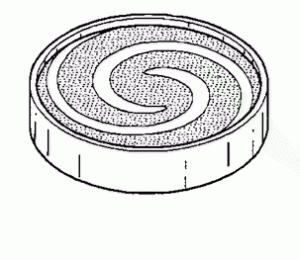 |
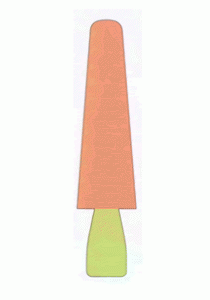 |
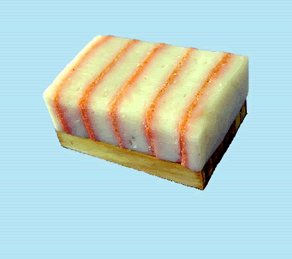 |
| No. 1317997 Solid Cosmetics with Container |
No. 1154256 Frozen Dessert with Bar |
No. 1211064 Fish Sausage with Board |
(Cited from the website of J-Plat Pat managed by National Center for Industrial
Property Information and Training)
5. Conclusion
The JPO’s decision of rejection has been revoked.
The present design is now registered as Design No. 1571832.